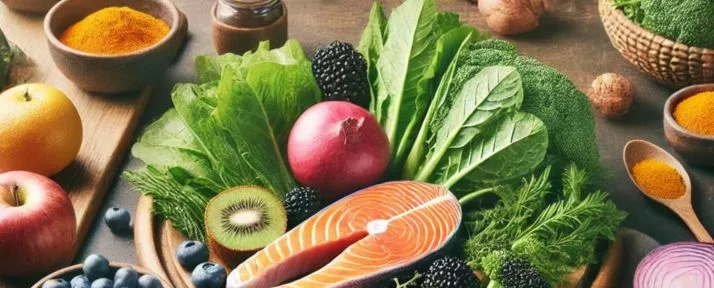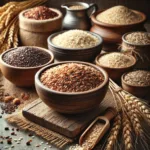
Have you ever wondered if the key to managing your chronic pain could be hiding in your kitchen? Chronic pain, a condition affecting millions worldwide, often feels like an unending battle. While medications and physical therapy offer some relief, they’re not always enough. What if the food you eat could play a significant role in reducing that pain? For many people, following an anti-inflammatory diet for chronic pain has made a powerful difference. This is where the anti-inflammatory diet comes in—a powerful approach that doesn’t just satisfy your taste buds but also fights inflammation, a major culprit behind chronic pain.
Understanding Inflammation and Its Role in Chronic Pain
Inflammation is a natural part of your body’s healing process. When you get injured or sick, your immune system kicks in, increasing blood flow to the affected area. This causes the redness, heat, and swelling you might notice around a wound or infection. But what happens when this inflammation doesn’t go away? Chronic inflammation can linger long after it’s needed, leading to pain that just won’t quit. Understanding how inflammation and pain are connected is key to managing your symptoms better
In chronic pain conditions like arthritis, fibromyalgia, or even long-term injuries, your body stays in a constant state of inflammation. This not only prolongs the pain but can also lead to tissue damage over time. The connection between inflammation and pain is well-established, and understanding it is crucial for managing your symptoms more effectively. Arthritis Foundation
The Science Behind the Anti-Inflammatory Diet
 This is where your diet comes into play. Certain foods can either help calm this inflammation or make it worse. For example, sugary snacks and processed foods are known to fuel inflammation, making pain worse. On the flip side, many fruits, vegetables, and healthy fats contain anti-inflammatory properties that can help soothe your body’s overactive immune response. This means what you eat can directly affect the levels of inflammation you experience.
This is where your diet comes into play. Certain foods can either help calm this inflammation or make it worse. For example, sugary snacks and processed foods are known to fuel inflammation, making pain worse. On the flip side, many fruits, vegetables, and healthy fats contain anti-inflammatory properties that can help soothe your body’s overactive immune response. This means what you eat can directly affect the levels of inflammation you experience.
Research has shown that diets rich in anti-inflammatory foods can significantly reduce inflammation and pain. Studies have found that people who follow these diets tend to have lower levels of inflammatory markers in their blood. This scientific backing gives us a solid reason to consider dietary changes as part of managing chronic pain. (Look for our upcoming article delving more into the diet-pain connection.)
The connection between food and inflammation isn’t just a theory—it’s backed by science. By choosing the right foods, you can potentially manage your pain more effectively. The next step is to learn which specific foods can help and how to incorporate them into your meals. Harvard Health
The Anti-Inflammatory Diet for Chronic Pain: A Natural Approach to Relief
Imagine eating foods that not only taste great but also help reduce your pain. That’s the essence of an anti-inflammatory diet. By choosing the right foods, you can potentially lower the levels of inflammation in your body, which may, in turn, reduce chronic pain.
The anti-inflammatory diet isn’t about strict rules or deprivation; it’s about making smarter choices (thank goodness because I like my food, lol!). It involves focusing on whole, unprocessed foods that are rich in nutrients. While the specifics of what you should eat will be covered in detail in our next article, here’s a quick glimpse of what’s involved:
- Fruits and Vegetables: These are packed with antioxidants, vitamins, and minerals that help combat inflammation.

- Healthy Fats: Foods like salmon, mackerel, and sardines are rich in omega-3 fatty acids, which are known to lower inflammation. If fish isn’t your thing, flaxseeds, chia seeds, and walnuts are great vegetarian sources of omega-3s.

- Spices and Herbs: Turmeric, a spice often used in Indian cooking, contains curcumin, a compound with strong anti-inflammatory effects. Ginger is another spice that can help reduce inflammation. Try adding these to your cooking for an extra health boost.

- Whole Grains: Foods like brown rice, oatmeal, and quinoa are high in fiber, which can help reduce inflammatory markers in the body. They are tasty and versatile, making it easy to include them in various meals throughout the day.

Integrating these foods into your diet doesn’t have to be a chore. Start simple with a berry-packed smoothie in the morning, a spinach salad for lunch, and some grilled salmon for dinner. Snacks can include nuts or a turmeric-spiced tea. The idea is to make these foods regular staples in your meals.
Practical Tips and Strategies for Adopting an Anti-Inflammatory Diet
Following an anti-inflammatory diet for chronic pain is one of the most sustainable ways to reduce inflammation and feel better long term. Transitioning to an anti-inflammatory diet might seem overwhelming at first, but it doesn’t have to be. Here are some practical strategies to help you get started:
- Start Small: You don’t need to overhaul your entire diet overnight. Begin by incorporating a few anti-inflammatory foods into your meals each week and slowly transition into an anti-inflammatory diet for chronic pain that fits your lifestyle. Maybe add some berries to your breakfast or swap your usual cooking oil for olive oil.
- Plan Your Meals: Meal planning is your best friend when it comes to sticking to an anti-inflammatory diet. By planning your meals ahead of time, you can ensure you’re including plenty of anti-inflammatory foods and avoiding the temptation of processed snacks.
- Focus on Whole Foods: Aim to eat foods that are as close to their natural state as possible. Fresh fruits, vegetables, whole grains, and lean proteins should be your go-to options. These foods not only help reduce inflammation but also provide essential nutrients that support overall health.
- Hydrate Wisely: This is the easiest and best way to get started and is the key for managing inflammation. Staying hydrated is crucial! Drink plenty of water throughout the day and consider adding herbal teas like ginger or turmeric tea, which have additional anti-inflammatory benefits.
- Seek Support: Making dietary changes can be challenging, but you don’t have to do it alone. Join online forums, social media groups, or local community organizations focused on healthy eating and chronic pain management. Sharing experiences and tips with others can make the journey easier and more enjoyable.
- Be Kind to Yourself: Change takes time. Don’t beat yourself up if you slip up or find it difficult to stick to your new eating habits. What’s important is consistency and making an effort to include more anti-inflammatory foods in your diet over time.
Final Thoughts 
An anti-inflammatory diet for chronic pain offers a promising, natural approach to relief and healing. By choosing foods that reduce inflammation, you can take control of your pain and improve your overall well-being. The journey might take some time, but the benefits are worth it. Start small, stay consistent, and remember—you’re not alone on this path. Remember, an anti-inflammatory diet for chronic pain isn’t a trend—it’s a smart, research-backed approach to healing from the inside out.
In our next article, we’ll dive deeper into the specific superfoods that can power your pain-free life, so stay tune!
JOIN OUR COMMUNITIES!


This post offers a refreshing perspective on managing chronic pain through diet. I love the idea that the foods we eat can actually help reduce inflammation and alleviate pain. It’s empowering to think about making small changes, like adding more fruits and healthy fats, rather than just relying on medications. The practical tips for incorporating these foods into daily meals make it feel achievable. Overall, it’s a hopeful reminder that we can take control of our health through our choices in the kitchen.
Thank you so much for your kind and thoughtful comment! I’m really glad that the post resonated with you. I really like the fact that this diet not only helps those with chronic pain, but it is a wonderful way to help through the aging process. It truly is empowering to realize how much control we can have over our health through the choices we make in the kitchen. Small, manageable changes like incorporating more fruits, vegetables, and healthy fats can make such a big difference, and it’s wonderful to hear that you found the tips practical and achievable. It’s all about finding what works best for you, and I’m so happy that this post provided a bit of hope and inspiration for your journey toward better health. Thanks again for taking the time to share your thoughts!
This was just the article I needed. I suffer from chronic pain due to inflammation and am glad I came across this. It explains everything and the section on tips I found very handy. Reading through the tips made me realize that is I switch to this anti-inflammatory diet it really is not going to be as hard as I thought it would be. I’ll be starting tomorrow. Thankyou!
Thank you so much for your kind words! 😊 I’m thrilled the article was helpful and that you found the tips encouraging. I hope the changes are going well for you so far! Remember, it’s all about taking it one step at a time—don’t be too hard on yourself as you adjust.
Switching to an anti-inflammatory diet can be challenging, but you’re not alone in this journey. Please don’t hesitate to reach out if you need any support or have questions along the way. I’m here to cheer you on and offer any encouragement you need! 🌱💪
Warm regards,
Courtney